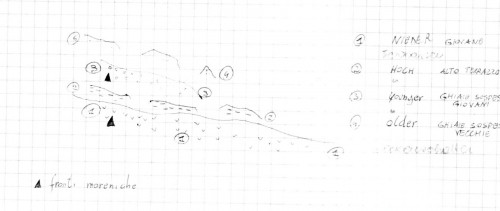Stefano Rossignoli 23 aprile 2011
Le Grandi Glaciazioni Quaternarie Parte I
Arriviamo quindi a ricordare come si è arrivati a capire che ci furono queste grandi Glaciazioni in tempi passati anche se non molto lontani…
Per fortuna nostra, ma soprattutto dei primi glaciologi i ghiacciai quando passano, avanzano e si ritirano, lasciano abbondanti nonché evidenti tracce.
Lasciano tracce molto chiare della loro esistenza ed evoluzione i piccoli ghiacciai alpini attuali, figuriamoci quelli enormi del passato…
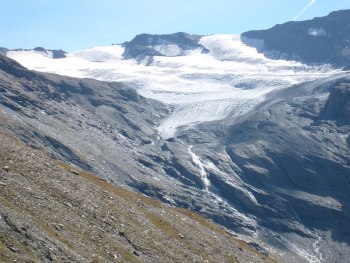
Le prime intuizioni sull’esistenza delle glaciazioni, sono state formulate proprio sulle Alpi svizzere da parte dei primi Glaciologi o comunque scienziati che si occupavano anche di questo, come ad esempio i famosi Charpentier e Agassiz.
Ufficialmente Charpentier fu il primo agli inizi dell’800 a formulare l’ipotesi che i ghiacciai fossero stati un tempo molto più grandi di quelli che si potevano vedere in quel periodo. …oggi sappiamo anche con certezza che nel 1800 i ghiacciai erano anche molto più grandi di come sono ora (vedi articolo dedicato alla Piccola Età Glaciale!).
Ma cosa vide Charpentier per cui pensò ad enormi ghiacciai?. Vide i cosiddetti massi erratici, blocchi di roccia (più o meno grandi) che a volte non c’entrano nulla con la roccia e l’ambiente che gli sta intorno. Ce ne sono moltissimi sulle Alpi e Prealpi. Addirittura arrivano da centinaia di chilometri di distanza e in altri continenti anche da migliaia… Ad esempio nei dintorni di Lecco in Lombardia ci sono i massi erratici di Serpentino e di Gneiss che provengono dalle valli laterali della Valtellina. Curiosamente le montagne intorno sono fatte da calcari e dolomie, rocce molto diverse sia alla vista, sia come origine…
Anche le strutture moreniche, relativamente facili da intercettare anche quando sono abbandonate da tempo a causa della loro forma e dell’orientazione dei grandi blocchi, fecero intuire a Charpentier che i ghiacciai dovevano essere stati enormi…
Agassiz perfezionò tali studi sulle forme lasciate dagli antichi ghiacciai intuendo che sulle Alpi doveva esserci stata una enorme copertura glaciale del tutto simile alla calotta attuale groenlandese…
Ovviamente, le teorie precedenti non consideravano questa ipotesi, in quanto fissiste e creazioniste. Come dico spesso, i primi evoluzionisti con cognizione di causa furono i geologi perchè l’evoluzione della Terra si vede direttamente e si può misurare… Oggi si vede benissimo cosa fanno e cosa lasciano i Ghiacciai. Ragionare sulle glaciazioni vuol dire semplicemente ragionare su quel che si vede ora, ma a scala più ampia…
Ora non dico che faremo un corso di Geologia del Quaternario, ma almeno tratteremo semplicemente qualche argomento di studio relativo ad alcune prove delle glaciazioni condotto dai primi geologi che intuirono non solo la glaciazione, ma addirittura il susseguirsi di glaciazioni quindi non possiamo tralasciare Penk e Brukner…
Chi erano? Erano due Geografi Austriaci che studiarono i terrazzi fluvio-glaciali e nel 1909 pubblicarono i loro studi geomorfologici sulle glaciazioni condotti sulle Alpi Bavaresi.
Ma quanti argomenti! Ma Stefano stai esagerando!!! Eh già, e lo stile blog non si presta proprio! …figuriamoci quando tireremo in ballo i Loess e magari altro…ma torniamo ai nostri terrazzi fluvio glaciali…
Il termine fluvio-glaciale indica un’origine congiunta di tale forma… La cosa vergognosa è che quando preparai l’esame di Geologia del Quaternario unimi avevo solo questo disegno e degli appunti sconfusionati e non ci capii nulla…!
L’origine di questi terrazzi che Penk e Bruckner studiarono nel nord delle Alpi, è invece piuttosto semplice da capire (ora che quei due lo hanno fatto per noi!!!).
1 – Immaginate GROSSI depositi di detriti (till o morene che siano) portati da grandissimi ghiacciai . Le varie alluvioni nonché l’erosione e il normale trasporto fluviale possono accumulare a valle enormi masse di questi detriti formando una sorta di mini-pianura (o grande conoide)-alluvionale…
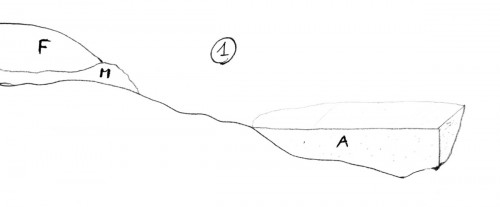
Abbreviazioni in figura: F=Fronte del Ghiacciaio, M=Morena A – A1 =Terreno Alluvionale di origine fluvioglaciale (Futuro terrazzo) – la linea di base sta ad indicarein modo semplificato il fondovalle, nonché l’alveo del fiume…
2 – Durante il ritiro (il periodo più caldo detto interglaciale) il fiume incide un solco più o meno profondo nei depositi lasciati in precedenza
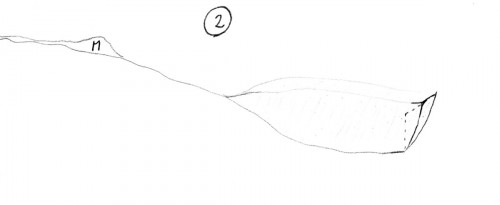
3 – Ora immaginiamo che passi molto tempo… Il tempo necessario per un’altra Glaciazione…il Ghiacciaio avrà accumulato a monte ancora un sacco di detrito
4 – Nuovamente, il detrito verrà portato a valle dai fiumi che nel frattempo avevano eroso e scavato la pianura precedente. I fiumi depositeranno quindi un altra piccola pianura alluvionale nel solco scavato in quella precedente che si trasformerà in un terrazzo che si troverà ad un livello un po’ più alto dell’ultimo che si è depositato…
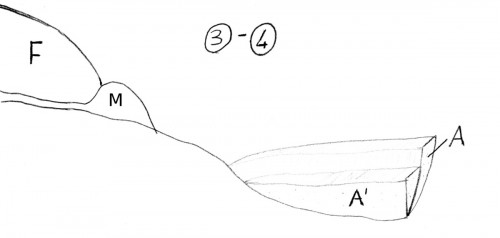
5 – Si ripete un altro ciclo ed un altro ancora ed il risultato sarà quello di 4 terrazzi via via sempre più bassi di quota!
Qui è un po’ il contrario della normale sedimentazione: in questo caso, ciò che è più antico sta più in alto a causa del modo in cui si è formato… Ovviamente nulla vieta al ghiacciaio di avanzare fino ai terrazzi e variarne quindi la morfologia.
Durante la deposiozione di un terrazzo siamo in una fase glaciale, il clima è più freddo e il ‘corridoio’ tra Alpi e calotta polare nord è caratterizzato da vegetazione di steppa… E’ quindi favorito il trasporto e la sedimentazione di materiale fine (50-70 micron) da parte del vento. Sul terrazzo in formazione non si noterà alcun deposito perchè il materiale eolico si mischierà con quello alluvionale, invece, sul terrazzo più vecchio si depositerà uno strato di materiale eolico (ovvero portato dal vento) detto Loess. Nella fase successiva di formazione di un nuovo terrazzo, si depositerà uno strato di Loess sul terrazzo della fase glaciale precedente e un’altro in più su quello di due glaciazioni precedenti e così via…
Sui terrazzi più antichi quindi ci saranno più strati di Loess rispetto a quelli più recenti che ne avranno di meno o addirittura nessuno.
I terrazzi del Danubio presentano queste tipiche caratteristiche in accordo ovviamente con le normali regole della sedimentazione (vedi fig.) con i loess più antichi al di sotto di quelli più recenti:

Ora si dovrebbe parlare di suoli, di morene, di micromammiferi, di pollini, di varve, di localizzazione delle grotte abitate nelle posizioni di fondovalle, di industrie litiche, tutti argomenti estremamente importanti nello studio e nell’interpretazione dei cambiamenti geomorfologici e climatici relativi al Quaternario, ma, oltre a non sentirmi in grado di farlo, la Geologia del Quaternario avrete capito, necessita di conoscenze talmente ampie che la pagina di un blog potrà solo, mi auguro, cominciare a rendere l’idea…
A presto e Buona Pasqua.
Stefano Rossignoli!
